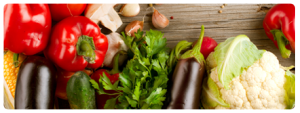Many can be eaten raw, some are best lightly cooked (i.e. blanched or dehydrated at relatively low temperatures, as in “raw” food preparation), and are delicious served hot or cold.
Artichoke | 1 cup |
Asparagus | 1 cup / 240 ml |
Bamboo Shoots | 1 cup / 240 ml |
Beet Greens | 1 cup / 240 ml |
Beet Root | 1 small or ½ cup / 120 ml |
Broccoli | ¾ cup / 170 ml |
Broccoli Rabe/Raab | 1 cup / 240 ml |
Brussels Sprouts | ¾ cup / 170 ml |
Cabbage, Green/Red | 1 cup / 240 ml |
Carrots | ¾ cup / 170 ml |
Cauliflower | 1 cup / 240 ml |
Chard | 1 cup / 240 ml |
Collard Greens | ¾ cup / 170 ml |
Daikon | 1 cup / 240 ml |
Dandelion Greens | 1 cup / 240 ml |
Eggplant | 1 cup / 240 ml |
Endive | 1 cup / 240 ml |
Escarole | 1 cup / 240 ml |
Fennel | 1 cup / 240 ml |
Green / French / String Beans | 1 cup / 240 ml |
Jicama | 1 cup / 240 ml |
Kale | 1 cup / 240 ml |
Kohlrabi | 1 cup / 240 ml |
Leek | 1 cup / 240 ml |
Mustard Greens | 1 cup / 240 ml |
Onion, Green / Spring (Scallion) | 1 cup / 240 ml |
Onion, white or red | 1 cup /1 medium |
Okra | 1 cup / 240 ml |
Pepper, Sweet Bell | 1 cup / 240 ml |
Radishes | 1 cup / 240 ml |
Rutabaga | ½ cup / 120 ml |
Spinach | 1 cup / 240 ml |
Snow Peas | 1 cup / 240 ml |
Summer Squash | 1 cup / 240 ml |
Tomato | 1 large or 1 cup / 240 ml |
Turnip | 1 cup / 240 ml |
Vegetable Salad (no dressing) | 1 cup / 240 ml |
Vegetable Juice | 1 cup / 240 ml |
Zucchini | 1 cup / 240 ml |
from the following:
Arugula
Baby Greens
Beet Greens, Raw
Bok Choy
Broccoli Rabe/Raab, Raw
Cabbage, Chinese
Celery
Chard, Raw
Chicory Greens
Collard Greens, Raw
Cucumber
Dandelion Greens, Raw
Endive, Raw
Escarole, Raw
Kale, Raw
Lettuce
Mushrooms
Mustard Greens, Raw
Seaweed
Spinach, Raw
Sprouts, Basil
Sprouts, Broccoli
Sprouts, Kale
Sprouts, Mung Bean
Sprouts, Radish
Turnip Greens, Raw
Watercress
the following:
Anise
Annatto
Basil
Bay Leaf
Cardamom
Caraway Seed
Celery Seed
Chervil
Chives
Cilantro
Cinnamon
Cloves
Coriander
Cumin
Dill Weed
Dill Seed
Epazote
Fennel Seed
Fenugreek
Garlic
Ginger Root
Horseradish
Hyssop
Juniper Berry
Kaffir Lime Leaves
Lavender
Lemon Balm
Lemon Grass
Lemon Verbena
Licorice
Mace
Marjoram
Mint (including Peppermint, Speamint, Sweet Mint, Wintergreen)
Mustard Seed
Nutmeg
Oregano
Paprika
Parsley
Pepper, Black
Pepper, Chili
Pepper, White
Rosemary
Saffron
Sage
Sassafras
Savory, Summer
Sorrel
Tarragon
Thyme
Turmeric
Vanilla
Simple and Healthy Cooking Ideas

The easiest, healthiest way to cook fresh or even frozen vegetables is steaming, followed by sautéing. These methods are quick and retain flavor and nutritional value – if not overcooked – and are generally light if done with minimal oil.
While many vegetables are tasty as is, simple seasonings can turn them into delicious delicacies – and increase their benefits! Herbs, spices, and other seasonings have been shown to carry their own nutritional power. Adding great flavor to cooked and raw vegetables is one way to ensure they earn a permanent place at just about any meal.
The following are the most common types of seasonings:
- Herbs – Fresh are best, but dried herbs certainly have their place. Sprinkle freely to taste over steaming vegetables, or when sautéing. The most popular are basil, oregano, marjoram, sage, and dill, but there are many others from which to choose.
- Spices – Spices are most often enjoyed dried, and best if ground just before use. The most common spices found in recipes include garlic and ginger (both fresh and dried), curry/turmeric, mustard and celery seeds, and black, white, and red peppers.
- Citrus. Add lemon juice or zest to vegetables like broccoli, green beans, and summer squash. You can also add lemon juice to the steaming water. Orange and grapefruit can also add a pleasant zing.
- Vinegars – Balsamic, red wine, or other infused vinegars are most often enjoyed with raw vegetables, but are also excellent additions to steamed vegetables – especially greens.
- Olive and nut and seed oils – After steaming, toss or sauté vegetables in herbs, spices, and/or oils. The most popular oils for these are olive and sesame, but nut oils such as almond and macadamia offer a buttery yet healthy zing. Some oils area also available already infused with herbs.
- Low-sodium broth/stock – Natural, low-sodium broths are basically combinations of dried vegetables and herbs which together create a classic seasoning for steamed vegetables. Add powder to the steaming water, or thicken the broth or stock with organic corn starch for a light sauce.
- Low-sodium soy sauce – A little bit goes a long way with soy sauce. Add a couple of teaspoons to steaming water or when sautéing with sesame oil and ginger or garlic.
